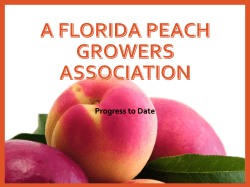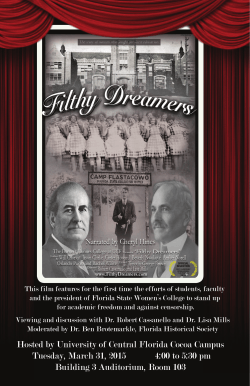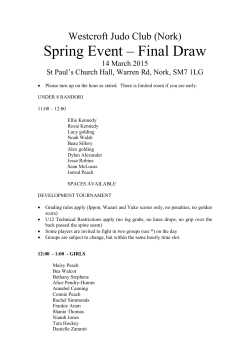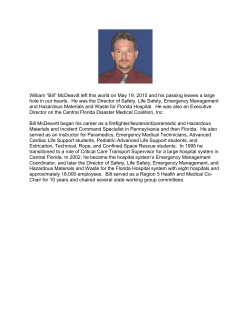
April 2015 - Lake County Extension
S p r i n g 2 0 1 5 C e n t r a l F l o r i d a E d i t i o n! N ! P EA C H e w s l e t t e UF & IFAS r Statewide Peach Continuing the Fight Best Management Spring Central Florida Agricultural Marketing Against White Peach Practices Peach Grower Order Scale Greeting peach growers. This is Roundtable An effort is currently underway.. If you sprayed your peach...…. an important message from...… Tuesday, May 12, 2015. Page 2 Page 3 Page 4 Page 6 SPRING ROUNDTABLE Our Spring Peach Roundtable Grower Meeting is scheduled for May Our Spring Central Florida Peach Grower Roundtable will be held on May 12, 2015. Registration information is located on the last page of the newsletter. The Roundtable Program will begin at 10:00 a.m. and be held at the UF/IFAS Pasco County Cooperative Extension Service Office in Dade City. Lunch will be provided by Tim Wood of Growers Fertilizer, so please make sure you register before the deadline. The Roundtable Educational Program will begin after a scheduled public hearing on a proposal for a Florida peach statue marketing order that begins at 10:00 a.m. The organizers of the statewide marketing order wanted to do this so local growers would have the opportunity to participate in discussion on the proposed peach order, plus it is a requirement in order to establish a public referendum. After the public meeting, we will have a presentation by Dr. Achour Amiri, Post Doctoral Associate in Plant Pathology from the Gulf Coast Research and Education Center in Balm on peach brown rot. As always if you have any questions, comments or suggestions for us, simply click on the agent of your choice from the email links at the bottom of each page or give us a call. UF & IFAS The SCIENCE of LIVING This newsletter is a product of UF, IFAS and County Cooperative Extension Services, in partnership with the participating Boards of County Commissioners and University of Florida “The Foundation for the Gator Nation” Chris Oswalt - wcoswalt@ufl.edu 863-519-1052• Gary England - gke@ufl.edu 352-343-4101• Alicia Whidden - awhidden@ufl.edu 813-744-5519 et 54134• Cami Esmel- cami13@ufl.edu 352-793-2728 S p r i n g 2 0 1 5 C e n t r a l F l o r i d a E d i t i o n! ! UF & IFAS P EA C H Additional Information and Public Meeting Locations The following locations and times have been set for public meetings on the proposed Florida Peach Marketing Order: May 12, 2015 at 10:00 a.m. Pasco County Extension Service 36702 SR 52 Dade City, FL May 20, 2015 at 2:00 p.m. Polk County Extension Service 1710 US Hwy 17 S Bartow, FL What is needed to pass a Marketing Order? Statewide Peach Marketing Order Chris Oswalt Extension Agent Polk County An effort is currently underway by Florida peach growers to establish a statewide peach marketing order. In this article I hope to provide some insight for you into what these orders provide and the process involved in establishing an agricultural order in the state of Florida. State marketing orders are a method for Florida producers to provide a source of funding (by a grower assessment or fee) and industry oversight for a number of commodity associated activities. These activities might include: • Promotion and advertising of their commodity A vote must be taken where 65 percent of those voting represent at least 51 percent of the voting peach acreage are in favor of the order. • Expansion of markets and distribution Can you end a Marketing Order? The Department of Agriculture can suspend or end a Marketing Order if it is no longer serving its original purpose or if 51 percent of the producers that grow more than 51 percent of the commodity vote to end the order. • For additional information on Florida Agricultural Marketing Orders see the following link: (http://www.freshfromflorida.com/DivisionsOffices/Marketing-and-Development/ Agriculture-Industry/Business-DevelopmentResources/Agricultural-Marketing-Orders) • Production research • Commodity grade and quality regulation Regulating trade practices • Addressing critical problems or needs of the industry. • These producers then pay a modest fee to the Department of Agriculture and Consumer Services to cover administrative costs of creating the marketing order • Public meetings must then be held to allow producers of the commodity an opportunity to voice their opinions, comments can also be submitted in writing to the Department of Agriculture • If at this time there is support of at least 10 percent of the producers and the proposed marketing order will accomplish the identified goals, the Commissioner of Agriculture will call for a vote • Next would be the actual vote on the marketing order by all producers, ballots are mailed to producers and then returned to the Department for tabulation • If the marketing order passes, it will then go into effect and a formal advisory council is appointed to make recommendations to the Commissioner of Agriculture on how it will be administered and the money spent. In order to establish a state agricultural marketing order, Florida law Marketing orders are overseen and requires that the following procedures must enforced by the Florida Department of be followed: Agriculture and Consumer Services. A Department marketing professional is • First interested growers must assigned to receive funds and keep meet together to share their accurate records on all expenditures. The information and plans with other farmers growing the same commodity Advisory Council representing producers of the commodity will make • When 10 percent or more of recommendations on how the money will growers of the same commodity agree be spent. The Council will also have the they want such an order, they must responsibility for preparing an annual submit a request/proposal to the budget and holding regular Council Commissioner of Agriculture to begin meetings. the process. Chris Oswalt - wcoswalt@ufl.edu 863-519-1052• Gary England - gke@ufl.edu 352-343-4101• Alicia Whidden - awhidden@ufl.edu 813-744-5519 et 54134• Cami Esmel- cami13@ufl.edu 352-793-2728 S p r i n g 2 0 1 5 C e n t r a l F l o r i d a E d i t i o n! ! UF & IFAS P EA C H Additional Information Continuing the Fight Against White Peach Scale Alicia Whidden Extension Agent Hillsborough County If you sprayed your peach trees this past winter for white peach scale, Pseudaulacaspis pentagona, check your trees again to be sure you killed all the scale. If you are seeing branches where the new growth and leaf cover is very thin, look the bark over good to be sure you do not see the colony, if the scale is still fluffy and white it is most likely alive and healthy and feeding on your peach tree. After summer pruning you will be able to see the limbs better, so take a good look at the trunk and scaffold branches. If you see white fluffy areas on the trunk, then you will need to use an insecticide to control the scale population and keep the numbers in check. This winter be sure to apply 2 dormant oil sprays. If you have a heavy infestation you may want to mix an insecticide with the oil. The Southeast Peach Guide lists Closeup of scale infested limb. (UF/Whidden) White peach scale on backside of limb. (UF/Whidden) Escaped white peach scale infestation. (UF/Whidden) signs of scale infestation. I have seen trees that have been sprayed several times for scale using an air blast sprayer and all the scale was not killed. The scale that survived has produced crawlers and they have spread on the trees and major limbs are slowly being killed. When looking at these trees it appears that the spray applications killed the scale on the top of the branches but scale survived on the underside of the limbs and now are spreading all along the limb and back to the trunk of the trees. Even if you do not see any movement in information on controlling white peach scale. There is probably no way to rid your trees completely of white peach scale once you have it, you will have to be diligent about scouting and spraying for it and the winter dormant oil sprays will be crucial. Chris Oswalt - wcoswalt@ufl.edu 863-519-1052• Gary England - gke@ufl.edu 352-343-4101• Alicia Whidden - awhidden@ufl.edu 813-744-5519 et 54134• Cami Esmel- cami13@ufl.edu 352-793-2728 S p r i n g 2 0 1 5 C e n t r a l F l o r i d a E d i t i o n! ! UF & IFAS P EA C H Peach Best Management Practices Jemy Hinton UF/IFAS BMP Implementation Greetings peach growers. This is an important message from your UF/IFAS BMP Team. In 2011, a Florida Department of Agriculture (FDACS) Florida Specialty Fruit and Nut Water Quality and Water Quantity Best Management Practices (BMPs) Manual was adopted by rule. This manual was developed by a multi-entity group of stakeholders, including growers, based on research and expert review, to prevent or reduce nutrient loadings to watersheds. and assessed in watersheds and management plans are established to address impairments. These plans are called Basin Management Action Plans (BMAPs) and have already been established for many watersheds in Florida. While enrolling in the BMP program has been voluntary throughout the state, a grower located in a BMAP area must enroll in the BMP program or, alternatively, work with DEP to develop an extensive…..and expensive monitoring plan. Most peach growers have embraced BMPs and have enrolled in the program. These practices include, nutrient management, irrigation management, sediment and erosion control, stormwater management, water resources protection, and integrated pest management. Most growers already use applicable practices and do not find enrolling in the program to be burdensome. For those growers who enroll in the BMP program, there are advantages. The obvious is the economic savings associated with more efficient nutrient and irrigation applications. The Mobile Irrigation Lab (MIL) is an invaluable free service offered to farmers for evaluating irrigation efficiencies. There are also other direct financial incentives. Several agencies provide costshare options for farms to assist in off-setting costs associated with implementing the BMP Program. FDACS, Natural Resources Conservation service (NRCS), Southwest Florida Water Management District Facilitating Agricultural Resource Management Systems (FARMS) program and the Hillsborough Soil and Water Conservation District all have financial assistance programs to help farmers implement costly practices. Record-keeping is a main tenant of BMPs. Growers who enroll in the program are not required to submit records, but are asked to maintain records of fertilizer and spray applications and irrigation/rain events and amounts. UF/L. DEP and FDACS are depending on grower enrollment to meet state water quality goals. We thank those farms who have signed up with the BMP program and encourage the rest to enroll as soon as possible. Peach enrollment is off to a great start, but still has a way to go. Growers should be aware that a watershed assessment effort is underway throughout Florida, spearheaded by the Department of Environmental Protection (DEP). Water quality is measured For further BMP information you may call Jemy Hinton UF/IFAS (813) 478-6630, Jessica Stempien FDACS (850) 510-5555 or of course, for information on any production issues, you may always call your UF/IFAS County Extension Agent. Chris Oswalt - wcoswalt@ufl.edu 863-519-1052• Gary England - gke@ufl.edu 352-343-4101• Alicia Whidden - awhidden@ufl.edu 813-744-5519 et 54134• Cami Esmel- cami13@ufl.edu 352-793-2728 S p r i n g 2 0 1 5 C e n t r a l F l o r i d a E d i t i o n! ! UF & IFAS P EA C H Pesticide Label Update Cami Esmel-McAvoy Extension Agent Sumter County Within the next year, you will start to see changes in how pesticides are labeled. All pesticide labels will now include pictograms and in some cases a ‘bee advisory box’ to protect pollinators. The pictograms, as well as other changes, are due to the final implementation deadline of Global Harmonization System of Chemical Hazards Classifications and Labeling through the Occupational Safety and Health Administration (OSHA). The implementation of the ‘bee advisory box’ is through the Environmental Protection Agency (EPA) as a way to protect pollinators from pesticide poisoning. Global Harmonization System (GHS) was negotiated between 67 countries to simplify labeling, reduced confusion and to help address literacy problems. The Hazard Communication portion of GHS covers labels and Safety Data Sheets (formally Material Safety Data Sheets). The nine black on white pictograms (figure 1) are described as the following: health hazard (star burst on person), flammable (flame), irritant or acute toxicity (exclamation mark), gas under pressure (gas cylinder), corrosion (hand and or metal with test tube dripping), explosives (exploding bomb), oxidizers (flame over circle), aquatic toxicity (dead fish and tree), and acute toxicity (skull and cross bones). The effective deadline for training all employees on the changes to the pesticide labels and SDS was on December 1, 2013, with compliance by June 1, 2015. Further information, including the hazard communication, links to training videos, and free Quick Reference Cards are available at https://www.osha.gov/dsg/hazcom/ index.html. The ‘bee advisory box’ contains a pictogram of a bee inside a red diamond, plus written instructions on application restrictions all within a black box. An example of the ‘bee advisory box’ can be downloaded using the following link: http://pesticidestewardship.org/ PollinatorProtection/Documents/bee-label-info-graphic.pdf. In addition to the ‘bee advisory box’, the Florida Department of Agriculture and Consumer Services has a Florida Managed Pollinator Protection Plan. While pollinators are not purchased for stonefruit production as they are in blueberries, you should be aware that several active ingredients are highly toxic to bees and will carry labeling restricting applications when bees are present (even if on flowering weeds). These include chlorpyrifos, methomyl, carbaryl, malathion, and permethrin. More information about Pesticide Stewardship can be found at http://pesticidestewardship.org/pollinatorprotection. Finally, new labels for neonicotinoids also will have the ‘bee advisory box’ on the label. This will likely remain until new pollinator risk assessments are completed. Figure 1. GHS pictogram classes. Chris Oswalt - wcoswalt@ufl.edu 863-519-1052• Gary England - gke@ufl.edu 352-343-4101• Alicia Whidden - awhidden@ufl.edu 813-744-5519 et 54134• Cami Esmel- cami13@ufl.edu 352-793-2728 S p r i n g 2 0 1 5 C e n t r a l F l o r i d a E d i t i o n! ! UF & IFAS P EA C H Spring Central Florida Peach Grower Roundtable additional questions please give us a call. You will not need to register for this public meeting. Our Spring Central Florida Peach Roundtable will be held at the UF/IFAS Pasco County Cooperative Extension Service Office in Dade City. The meeting will be on Tuesday, May 12, 2015, beginning at 10:00 a.m. We will be hosting a public meeting on the proposed Florida peach marketing order. Then at about 11:00 a.m. we will begin our Peach Grower Roundtable. Lunch will be served at the conclusion of the Roundtable at about 12:00 noon. Our sponsor for this Roundtable will be Tim Wood and Growers Fertilizer. Stuart Conference Center! 1710 US Hwy 17 South! Bartow, FL We hope to see you on the 12th or the 20th, To attend we will need you to preregister by calling Gail Crawford at 863-519-1042 or email her at: dorothyc@ufl.edu. We will need to have this done by Friday, May 8, 2015. The address of the Pasco County Cooperative Extension Service is 36702 State Road 52, Dade City, FL (see above map). Chris Oswalt Citrus Extension Agent Polk/Hillsborough Counties Phone 863-519-1052 P.O. Box 9005, Drawer HS03 Bartow, FL 33831-9005 Florida Peach Marketing Order Public Meeting There will be a second public meeting on the proposed Florida Peach Marketing Order on Wednesday, May 20, 2015 at the Stuart Conference Center at 1710 US Hwy 17 S. in Bartow, FL (see map). The meeting will begin at 2:00 p.m. If you have any The Foundation for The Gator Nation An Equal Opportunity Institution Chris Oswalt - wcoswalt@ufl.edu 863-519-1052• Gary England - gke@ufl.edu 352-343-4101• Alicia Whidden - awhidden@ufl.edu 813-744-5519 et 54134• Cami Esmel- cami13@ufl.edu 352-793-2728
© Copyright 2025









